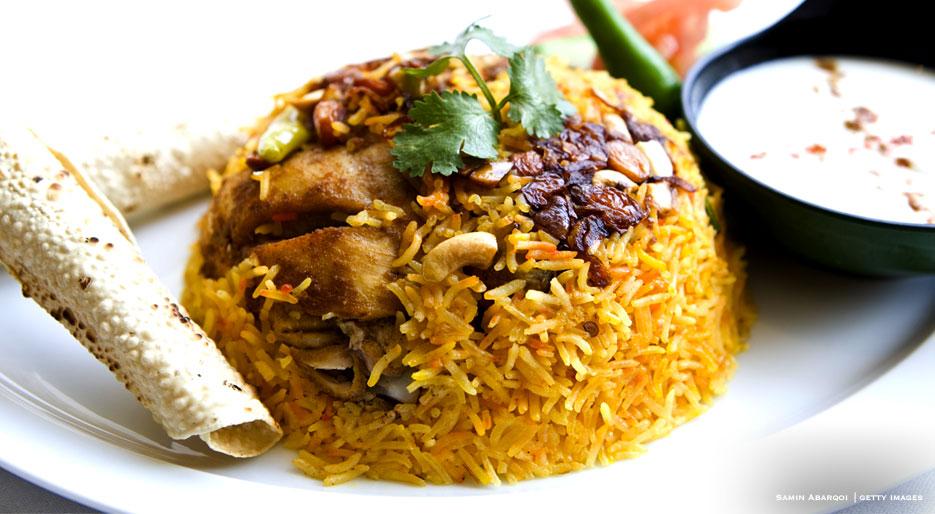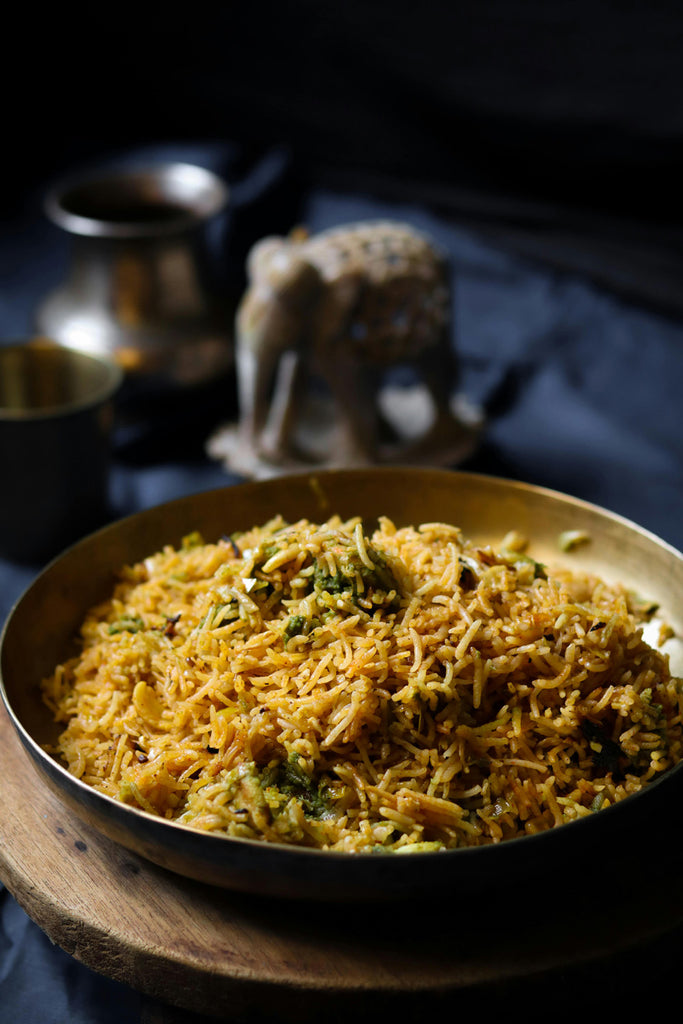
Introduction
Explanation Of Biryani And Its Popularity
Biryani is a popular rice dish that originated in the Indian subcontinent. It is known for its rich flavors and aromatic spices. The dish is made by cooking rice with meat or vegetables and a variety of spices such as cardamom, cinnamon, cloves, and saffron. Biryani has become popular not only in India but also in other parts of the world due to its unique taste and diverse variations.
Why Mastering The Art Of Cooking Biryani Is Important
Mastering the art of cooking Biryani is important for several reasons:
- Cultural Significance: Biryani is a dish deeply rooted in the cultural heritage of the Indian subcontinent. It is often served during special occasions and festivals, symbolizing celebration and togetherness. By mastering the art of cooking Biryani, one can appreciate and preserve this cultural tradition.
- Culinary Exploration: Biryani offers a wide array of flavors and ingredients, allowing cooks to experiment with different combinations and techniques. Mastering the art of cooking Biryani opens up a world of culinary exploration and creativity, enabling cooks to develop their own unique recipes and variations.
- Palate Pleasing: Biryani is loved by people of all ages and tastes. With its aromatic spices and flavorful ingredients, it is a crowd-pleaser at parties and gatherings. By mastering the art of cooking Biryani, one can create delicious, satisfying meals that are sure to impress family and friends.
- Versatility: Biryani can be made with various meats, vegetables, and even seafood, making it a versatile dish that can be customized to suit different dietary preferences. Mastering the art of cooking Biryani allows cooks to experiment with different combinations and adapt the dish to accommodate various dietary restrictions.
In conclusion, mastering the art of cooking Biryani not only allows one to enjoy the flavors and cultural significance of this beloved rice dish but also empowers cooks to explore their creativity in the kitchen. Whether you are a seasoned cook or a beginner, diving into the world of Biryani can be a fulfilling culinary experience. So, grab your apron and start mastering the art of cooking Biryani today!
Understanding Biryani
Different Types And Variations Of Biryani
Biryani is a versatile dish that comes in various types and variations, each with its own unique flavor profile. Some popular types of Biryani include:
- Ambur Biryani: This type of Biryani originated in the town of Ambur in Tamil Nadu and is known for its spicy flavor and the use of short-grain rice.
- Hyderabadi Biryani: This Biryani is a staple in Hyderabadi cuisine and is made with basmati rice, meat (usually chicken or goat), and a blend of aromatic spices. It is often garnished with fried onions and served with raita.
- Kolkata Biryani: Kolkata Biryani is influenced by Awadhi and Mughlai cuisines. It is made with basmati rice, meat (typically goat or chicken), and features potatoes and eggs as additional ingredients.
- Memoni Biryani: This type of Biryani is a specialty of the Memon community in Pakistan. It is made with basmati rice, meat (usually beef or mutton), and is known for its spicy and aromatic flavors.
There are many more variations of Biryani, each with its own regional twist and unique combination of ingredients. No matter the type, Biryani is known for its flavorful rice, tender meat, and fragrant aroma.
Essential Ingredients And Spices Used In Biryani
To make a delicious Biryani, certain essential ingredients and spices are used. These include:
| Ingredients | Spices |
|---|---|
| – Basmati rice | – Cardamom |
| – Meat (chicken, goat, beef, or mutton) | – Cinnamon |
| – Onions | – Cloves |
| – Yogurt | – Saffron |
| – Ghee or oil | – Ginger |
| – Garlic | – Green chilies |
| – Fresh herbs (such as mint and cilantro) | – Turmeric |
These ingredients and spices work together to create the distinct flavors and aromas that are characteristic of Biryani. The combination of basmati rice, tender meat, and fragrant spices makes Biryani a truly indulgent dish.
In summary, Biryani is a beloved rice dish that offers a wide range of flavors and variations. With its essential ingredients and aromatic spices, Biryani has become an integral part of the culinary heritage of the Indian subcontinent. Whether you prefer the spicy Ambur Biryani or the fragrant Hyderabadi Biryani, mastering the art of cooking Biryani allows you to savor the rich flavors and explore the diverse world of this celebrated dish.
Understanding Biryani
Different Types And Variations Of Biryani
Biryani is a versatile dish that comes in various types and variations, each with its own unique flavor profile. Some popular types of Biryani include:
- Ambur Biryani: Originating from the town of Ambur in Tamil Nadu, this Biryani is known for its spicy flavor and the use of short-grain rice.
- Hyderabadi Biryani: A staple in Hyderabadi cuisine, this Biryani is made with basmati rice, meat (usually chicken or goat), and a blend of aromatic spices. It is often garnished with fried onions and served with raita.
- Kolkata Biryani: Influenced by Awadhi and Mughlai cuisines, Kolkata Biryani features basmati rice, meat (typically goat or chicken), and includes potatoes and eggs as additional ingredients.
- Memoni Biryani: A specialty of the Memon community in Pakistan, this Biryani is made with basmati rice, meat (usually beef or mutton), and is known for its spicy and aromatic flavors.
There are many more variations of Biryani, each with its own regional twist and unique combination of ingredients. No matter the type, Biryani is known for its flavorful rice, tender meat, and fragrant aroma.
Essential Ingredients And Spices Used In Biryani
To make a delicious Biryani, certain essential ingredients and spices are used. These include:
| Ingredients | Spices |
|---|---|
| – Basmati rice | – Cardamom |
| – Meat (chicken, goat, beef, mutton) | – Cinnamon |
| – Onions | – Cloves |
| – Yogurt | – Saffron |
| – Ghee or oil | – Ginger |
| – Garlic | – Green chilies |
| – Fresh herbs (mint and cilantro) | – Turmeric |
These ingredients and spices work together to create the distinct flavors and aromas that are characteristic of Biryani. The combination of basmati rice, tender meat, and fragrant spices makes Biryani a truly indulgent dish.
Step 1 – Preparing The Marinade
Marinating The Chicken Or Meat With Spices And Yogurt
To make the best chicken biryani, marinating the chicken with yogurt and spices is an essential first step. The yogurt tenderizes the chicken while the spices enhance the flavors. If you do not eat curd, you can substitute it with coconut milk.
The Importance Of Marinating For Enhancing Flavors
Marinating the chicken and letting it rest allows the flavors to penetrate the meat, resulting in tender and succulent chicken. It is crucial not to skip this step as it contributes to the overall taste and texture of the biryani.
In summary, Biryani is a beloved rice dish that offers a wide range of flavors and variations. With its essential ingredients and aromatic spices, Biryani has become an integral part of the culinary heritage of the Indian subcontinent. Whether you prefer the spicy Ambur Biryani or the fragrant Hyderabadi Biryani, mastering the art of cooking Biryani allows you to savor the rich flavors and explore the diverse world of this celebrated dish.

Understanding Biryani
Different Types And Variations Of Biryani
Biryani is a versatile dish that comes in various types and variations, each with its own unique flavor profile. Some popular types of Biryani include:
- Ambur Biryani: Originating from the town of Ambur in Tamil Nadu, this Biryani is known for its spicy flavor and the use of short-grain rice.
- Hyderabadi Biryani: A staple in Hyderabadi cuisine, this Biryani is made with basmati rice, meat (usually chicken or goat), and a blend of aromatic spices. It is often garnished with fried onions and served with raita.
- Kolkata Biryani: Influenced by Awadhi and Mughlai cuisines, Kolkata Biryani features basmati rice, meat (typically goat or chicken), and includes potatoes and eggs as additional ingredients.
- Memoni Biryani: A specialty of the Memon community in Pakistan, this Biryani is made with basmati rice, meat (usually beef or mutton), and is known for its spicy and aromatic flavors.
There are many more variations of Biryani, each with its own regional twist and unique combination of ingredients. No matter the type, Biryani is known for its flavorful rice, tender meat, and fragrant aroma.
Essential Ingredients And Spices Used In Biryani
To make a delicious Biryani, certain essential ingredients and spices are used. These include:
| Ingredients | Spices |
|---|---|
| – Basmati rice | – Cardamom |
| – Meat (chicken, goat, beef, mutton) | – Cinnamon |
| – Onions | – Cloves |
| – Yogurt | – Saffron |
| – Ghee or oil | – Ginger |
| – Garlic | – Green chilies |
| – Fresh herbs (mint and cilantro) | – Turmeric |
These ingredients and spices work together to create the distinct flavors and aromas that are characteristic of Biryani. The combination of basmati rice, tender meat, and fragrant spices makes Biryani a truly indulgent dish.
Step 2 – Cooking The Biryani Pot
Preparing The Base Of The Biryani With Onions And Spices
In a deep Biryani pot, fry 2 large thinly sliced onions in 4 tbsp oil until they are dark brown and crispy. Set aside.
Adding The Marinated Chicken And Fried Onions For Richness
In the same Biryani pot, add 1 tbsp butter or ghee, 2 tbsp whole Biryani spices, 1 tbsp ginger-garlic paste, and the prepared chili-tomato paste. Cook until the oil separates from the paste. Then, add the marinated chicken and 2 tbsp of the fried onions.
Cooking the Biryani pot with these ingredients creates a flavorful base for the Biryani. The fried onions add a rich, caramelized taste while the spices infuse the dish with their aromatic flavors. This step is crucial in achieving the perfect balance of flavors in Biryani.
Step 3 – Bringing It All Together
Cooking The Rice Separately And Adding It To The Biryani Pot
To bring all the flavors together, the rice is cooked separately and then added to the Biryani pot. Here’s how this step is done:- In a separate pot, bring 2 liters of water to a boil.- Add ½ tbsp ginger-garlic paste, 2 tbsp green chilies, ½ tsp of the prepared Biryani masala powder, 3 tsp salt, ½ tsp oil, and 1 tsp each of mint and coriander leaves to the boiling water.- Drain the soaked rice and add it to the pot. Cook until the rice is 90% done, which takes about 10-15 minutes.
Layering Technique For Ensuring Even Distribution Of Flavors
To ensure that each bite of Biryani is bursting with flavors, a layering technique is employed. Here’s how it’s done:1. Check if the chicken is cooked. If it’s not fully cooked, cover and cook on low flame until done.2. Once the chicken is cooked, add the partially cooked rice on top of it in the Biryani pot.3. Sprinkle some fried onions and a pinch of saffron soaked in milk on top of the rice.4. Repeat another layer of chicken and rice, along with fried onions and saffron milk.5. Ensure that each layer is evenly distributed and covers the entire pot.6. Cover the pot with a tight-fitting lid and place it on low heat for about 20-30 minutes to allow the flavors to meld together.7. Once the Biryani is cooked, gently mix the layers before serving to distribute the flavors evenly.
By following these steps and techniques, you can create a flavorful and fragrant Biryani right at home. The layering technique ensures that each spoonful of Biryani is a delight to the taste buds, with the tender meat, aromatic spices, and perfectly cooked rice coming together in harmony.
Step 4 – Dum Cooking
Covering The Biryani Pot And Cooking On Low Flame For A Specific Time
To ensure that all the flavors are infused into the rice and meat, the next step is dum cooking. Dum cooking involves sealing the pot tightly to retain moisture and cooking the biryani on a low flame for a specific time. Here’s how it’s done:
- Seal the pot tightly with a lid to create a steamy environment for the biryani.
- Place the pot on a flat-based pan to avoid direct heat, as this will prevent burning.
- Cook the biryani on a low flame for about 10-15 minutes. This slow cooking process allows the flavors to meld together and ensures that the rice and meat are cooked to perfection.
- It’s important to resist the temptation to open the lid during the cooking process, as this can disrupt the steam and affect the final outcome of the biryani.
Retaining Moisture And Allowing The Flavors To Blend
After the dum cooking process, it’s essential to let the biryani rest before serving. This step allows the flavors to blend and the rice to absorb any remaining moisture. Here’s what you need to do:
- After cooking the biryani, let it rest for about 10 minutes before opening the lid. This resting time allows the flavors to fully develop and gives the rice a chance to become fluffy and grainy.
- Once the resting period is over, gently mix the layers of biryani to distribute the flavors evenly. This step ensures that each spoonful of biryani is a delightful combination of tender meat, aromatic spices, and perfectly cooked rice.
Following these cooking techniques and steps will help you create a flavorful and fragrant biryani right in your own kitchen. The dum cooking process adds depth and richness to the dish, while the resting time allows the flavors to harmonize. With practice and precision, you can master the art of making biryani and impress your family and friends with a delicious homemade meal.
Step 5 – Garnishing And Serving
Adding Final Touches With Fried Onions, Mint, And Coriander Leaves
To complete the biryani preparation, it’s time to add some final touches and garnishes that will enhance the flavors and presentation of the dish. Here’s what you need to do:
- Finely slice half an onion and fry it until it turns crispy and golden brown. These fried onions will add a delicious crunch and sweetness to the biryani.
- Next, chop some fresh mint leaves and coriander leaves. These herbs will not only enhance the visual appeal of the biryani but also add a refreshing and aromatic element to the dish.
- To garnish the biryani, start by layering the rice with chopped cilantro, mint leaves, and fried onions. This will create a beautiful and flavorful top layer that will make the dish even more appetizing.
Tips For Serving Biryani Hot And With Accompaniments
Once the biryani is garnished and ready, it’s time to serve it and enjoy the flavorsome creation. Here are some tips to ensure you serve the biryani perfectly:
- Serve the biryani hot, as the flavors and aromas are at their best when it’s freshly cooked. The warmth will also enhance the overall taste and experience.
- Pair the biryani with some cooling yogurt raita and a zesty salad. The yogurt raita will help balance the spices and provide a refreshing contrast, while the salad will add some crunch and freshness to the meal.
- When serving the biryani, gently fluff the layers with a fork to allow the intoxicating scent to escape. This will create a sensory experience that will make the meal even more enjoyable.
Now that you’ve mastered the art of making biryani and learned the steps involved in creating this flavorful rice dish, it’s time to indulge in the culinary masterpiece you have prepared. The garnishing and serving steps add the final touches that elevate the biryani to a whole new level. With fried onions, fresh herbs, and the right accompaniments, your biryani is ready to be savored and enjoyed by friends and family.

Biryani Variations And Fusion Recipes
Exploring Different Regional Variations Of Biryani
Biryani is a versatile dish that has evolved and adapted to various regional cuisines in India and beyond. Each region has its own unique take on this flavorful rice dish, incorporating local ingredients and cooking techniques. Here are some popular regional variations of Biryani:
- Hyderabadi Biryani: Known for its rich and aromatic flavors, Hyderabadi Biryani uses basmati rice, meat (usually chicken or mutton), and a blend of spices like saffron, cardamom, and cloves. It is traditionally cooked in layers, with the meat and rice cooked separately and then layered together before serving.
- Lucknowi Biryani: Originating from the Awadh region of Uttar Pradesh, Lucknowi Biryani is characterized by its delicate flavors and the use of fragrant spices like rose water and kewra water. It is known for its Dum Pukht style of cooking, where the meat and rice are sealed in a pot and slow-cooked over a low flame.
- Kolkata Biryani: Kolkata Biryani has a distinct flavor due to the addition of potatoes and a unique blend of spices, including bay leaves, cinnamon, and nutmeg. It is lighter in spice compared to other variations and is often served with a side of boiled eggs and aloo dum (spicy potato curry).
- Mumbai Biryani: Mumbai Biryani is a fusion of flavors influenced by the city’s diverse culinary traditions. It is typically made with basmati rice, meat (usually chicken), and a blend of spices like ginger, garlic, and green chilies. It incorporates elements of both Maharashtrian and Muslim cuisine, resulting in a flavorful and spicy biryani.
Incorporating Global Ingredients And Flavors For Unique Biryani
Biryani has also become a canvas for creative chefs to experiment with global ingredients and flavors, resulting in unique fusion recipes. Here are some examples:
- Mexican Biryani: This fusion recipe combines the traditional biryani spices with Mexican ingredients like jalapenos, bell peppers, and black beans. It adds a spicy and tangy twist to the classic biryani flavors, creating a fusion dish that is both delicious and unexpected.
- Thai Biryani: Incorporating the flavors of Thailand, this fusion recipe includes ingredients like lemongrass, coconut milk, and Thai curry paste. It adds a fragrant and aromatic element to the biryani, resulting in a flavorful blend of Indian and Thai cuisines.
- Mediterranean Biryani: Infused with the flavors of the Mediterranean, this fusion biryani recipe combines ingredients like sundried tomatoes, olives, and feta cheese. It brings a tangy and savory twist to the traditional biryani, creating a fusion dish that is sure to tantalize your taste buds.
These variations and fusion recipes showcase the versatility of biryani and the endless possibilities for creating unique and flavorful dishes. Whether you prefer the traditional regional flavors or enjoy experimenting with global ingredients, biryani is a culinary adventure that promises to satisfy your cravings. So go ahead, explore the world of biryani and embark on a flavorful journey that will leave you craving for more.
Conclusion
Sharing Personal Experiences With Cooking Biryani
Cooking Biryani is not just about preparing a meal, it is a sensory experience that engages all your senses. From the moment you start sautéing the spices, to the wafting aroma filling your kitchen, to the final step of garnishing your plate, each step in the process is a labor of love. As a seasoned chef or a beginner in the kitchen, Biryani Chronicles provides you with a comprehensive cookbook that will guide you through the art of preparing diverse biryani delicacies.
Encouraging Readers To Experiment And Enjoy The Process
One of the joys of cooking is the freedom to experiment and make a dish your own. While this cookbook provides you with traditional and fusion biryani recipes, don’t be afraid to add your own twist to the mix. Feel free to incorporate your favorite ingredients, spices, and cooking techniques to create a biryani that reflects your personal taste and style. Remember, the key to a flavorful and aromatic biryani lies in the enjoyment and passion you bring to the process. So, gather your ingredients, unleash your creativity, and embark on a culinary adventure that will delight your taste buds and leave you craving for more. Share your cooking experiences with friends and family, and spread the love for biryani with others on social media. Happy cooking and bon appétit!
FAQ: How to Cook Biryani – Culinary Chronicles of Biryani Preparation
- What is biryani?
Biryani is a flavorful and aromatic rice dish that originated in the Indian subcontinent. It is made by cooking long-grain rice and meat (such as chicken, lamb, or beef) together with spices, herbs, and sometimes vegetables. Biryani is loved for its fragrant aroma and rich taste. - What are the different types of biryani?
There are various types of biryani found across different regions. Some popular ones include Hyderabadi biryani, Lucknowi biryani, Kolkata biryani, and Bombay biryani. Each has its own unique combination of spices and cooking techniques, resulting in distinct flavors. - How do I cook biryani?
Cooking biryani requires a few steps, but with proper preparation, it can be a delicious and rewarding experience. Here’s a basic guide:- Step 1: Soak the rice in water for 30 minutes, then drain and set aside.
- Step 2: Marinate the meat with spices, yogurt, and any other desired ingredients. Let it sit for at least 30 minutes to allow the flavors to meld.
- Step 3: Heat oil or ghee in a deep, heavy-bottomed pot. Add whole spices like cardamom, cinnamon, and cloves, followed by sliced onions. Cook until the onions turn golden brown.
- Step 4: Add the marinated meat and cook until it is partially cooked. This helps infuse the flavors into the meat.
- Step 5: Layer the parboiled rice on top of the meat. Sprinkle saffron-infused milk or food color, fried onions, and chopped herbs.
- Step 6: Cover the pot tightly with a lid and cook on low heat for about 30-40 minutes or until the rice and meat are fully cooked.
- Step 7: Once cooked, gently fluff the rice with a fork and serve hot.
- Can I make a vegetarian biryani?
Absolutely! Biryani can be made with vegetables, or a combination of vegetables and rice. The cooking process remains the same, but the marination and spices can be adjusted to suit vegetarian preferences. - Can I use a pressure cooker to make biryani?
Yes, you can cook biryani in a pressure cooker for a quicker result. Follow the same steps until the layering of rice. Instead of covering the pot, lock the pressure cooker and cook for about 2-3 whistles. Allow the pressure to release naturally before opening. - How do I ensure my biryani rice is not sticky?
To avoid sticky rice, it’s important to soak the rice and rinse it well before cooking. Parboiling the rice until it is 70-80% cooked also helps. Additionally, when layering the rice with the partially cooked meat, make sure to add enough moisture by adding some warm water or saffron-infused milk to prevent dryness. - Can I customize the spices in biryani?
Absolutely! Biryani is a versatile dish, and you can adjust the spices according to your taste preferences. Increase or decrease the amount of spicy elements like chili powder, ginger, garlic, or whole spices to create a flavor profile that suits you.
Remember, practice makes perfect when it comes to cooking biryani. Experiment with different ingredients to discover your favorite flavors and enjoy the delightful journey of preparing this beloved dish.

New Indian Cafe offers delicious dining and takeout to Greenwood Village, CO.
New Indian Cafe is a cornerstone in the Greenwood Village community and has been recognized for its outstanding Indian cuisine, excellent service, and friendly staff.
Our Indian restaurant is known for its modern interpretation of classic dishes and its insistence on using only high-quality, fresh ingredients.